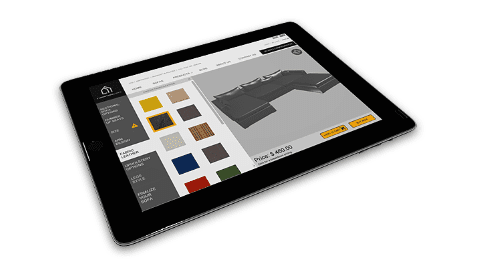B2B (business-to-business) enterprises often receive unique product demands that require custom solutions to fulfill them. In the last few years, a digital solution has emerged and helped a lot of companies fulfill these demands while boosting sales. That solution is nothing more, than a 3D product configurator.
The CPQ (Configure, Price, Quote) market is rising and predicted to grow by 14% annually between 2021-2025 for total growth of $1.49 billion. Product configurators are an important component of a CPQ suite. They help in customizing complex product demands and generating real-time quotes.
Improved sales processes, fewer manufacturing faults, automated services, and better customer engagement, are the other benefits that can save you a lot of time, money, and resources.
This article digs deeper into the uses and benefits of 3D product configurators in B2B commerce.
What Is a 3D Product Configurator?
A 3D product configurator is a digital tool that uses live 3D models to assist customers with interactive personalized visualization options. Naturally, a 3D configurator allows users to customize and preview their customized product at the same time while receiving detailed real-time price quotes, which results in an enriched purchasing experience.
Lately, more people are delaying offline in-store options to buy products using media files such as images and videos to assist them while buying. But is this enough? While customers are looking for a more personalized experience and products, product images or videos alone won’t be enough. That’s why you must have a 3D product configurator on your site.
With a 3D product configurator, businesses can reduce return rates, boost sales, and have better brand engagement. On average, businesses earn six dollars for every dollar they invest in CPQ software, with product configurators as an important part of it.
3D configurators allow users to change different attributes of any product such as size, color, features, materials, or accessories. Instead of creating manual quotes and specifications for a user’s preferences, a 3D product configurator can automate the entire process and speed up the buyer’s journey.
Ways to Boost Your B2B Sales
Recently, DIY and self-service platforms have gained a lot of popularity as customers pursue more personalized products. By using the outstanding potential of the 3D product configurator, B2B companies can effectively improve their sales process, provide a personalized user experience, and get better product feedback.
Here are the six ways how a 3D product configurator can boost your B2B business sales:
1. Higher Customer Satisfaction
Bridging the gap between what your customer wants and what you deliver has never been more difficult. Buyers are no longer willing to wait for several days or weeks before seeing their purchase and determining if it meets their expectations or not. Businesses spend a big amount of money on improving their sales processes and equipment to satisfy the ever more demanding customers.
With no feature of customizing their order and quickly getting a quote will only push your customer to another brand. Let’s suppose you sell furniture. Customers can interact and take the complete privilege of the product by customizing some of the specifications like width, height, color, and depth.
With an interactive 3D visualization and configuration product, you can gain higher customer satisfaction.
2. Low Return Rates
When you satisfy your customers, they won’t return the product – and that’ll lower your return rates. Having a 3D configurator won’t just lead to improved customer satisfaction, it also ensures that your product doesn’t end up being dumped or returned when it doesn’t meet the customer’s expectations.
3. Low Need for Sales Representatives
In a traditional buying process, customers have to reach out to sales representatives to get important information on a product such as material availability, price, customization options, and delivery dates. The sales representative will guide you through your requirements and preferences and then explore other configuration options with you. This process takes a lot of time and a drain on resources.
With a 3D configurator, you can instantly figure out what the customer wants, deliver a price calculated upon product customization, and direct them to a faster and more simplified buying process without involving unnecessary sales reps.
4. More Data; Better Optimized Products
When your customers will interact with your 3D product configurator, they left a lot of valuable data that you can use to optimize customer engagement. You can track and find the most common areas and product preferences where your customers disengage, feel confused, and more.
Having this massive amount of data ensures you can offer your customers a better sales process, product functionality, improvements, and ultimately better customer engagement and satisfaction.
5. Higher ROI with Customized Selling
Of course, a sale must make a profit. But how can a 3D product configurator improve ROI? First, you can lower production mistakes. The online product configurator offers a wide range of settings and features, especially in B2B that allows customers to run automated checks on the products to ensure feasibility so they can make informed decisions.
In some cases, a customer can get lost in all the features and might pick the wrong component for a certain product. But a product configurator reduces these types of errors by ensuring that only possible combinations are made or available. Second, the configurator guides users through a set of questions and prompts to suggest options for upselling and cross-selling.
Yet, a good product may sell itself, but a better customer experience increases retention, drives more traffic, and promotes visibility. Visualizing a product in real-time gives customers the closest experience to the real thing. It allows them to change details and try out different variations until they’re satisfied.
6. Third-Party Software Integrations (ERM, CRM, etc.)
You don’t want your customers to just see the product, you want to take them through your enterprise platforms. You want to interact with them through ERP, ERM, or CRM software to track their viewpoints and engagements through a CDP, and so on.
The goal of a 3D configurator is to simplify the retail experience process by facilitating integration with third-party software. By doing so, you’ll build a strong customer relationship and that’ll ultimately increase your B2B sales. Because, if a customer is not satisfied, your product isn’t worth it.
Conclusion
3D product configurators are the next big thing in the world of eCommerce. If you’re interested in coping with the latest technologies to improve your business and sales, you gotta give it a try. It’ll not only give your business an advantage over the competition but also help you build a strong relationship with your customer and build a business focused on customer satisfaction and retention, not just making cold sales.
Contact Simplio3D today and schedule your call to discuss your business. They’re one of the most reliable and professional guys working in the industry. It’ll be worth your money to check them out and see what magic they can bring to your business.
Author bio: Anna Wattson is a content strategist and marketer working with various brands and firms online. She is devoted to helping small businesses succeed online by providing them with in-depth and actionable advice on digital marketing, SEO, and small business growth. Follow her on @annawattson24.



































